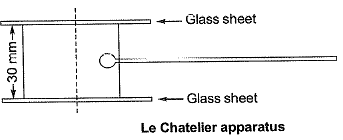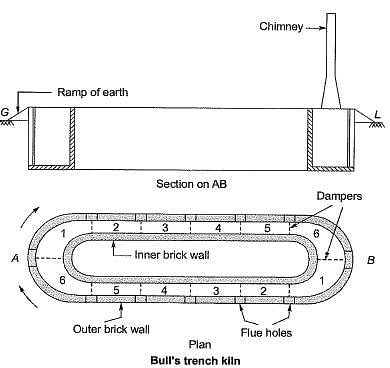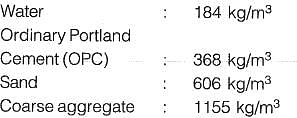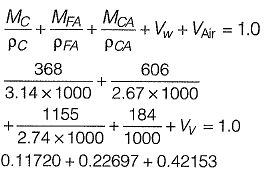Past Year Questions: Construction Materials | Topic wise GATE Past Year Papers for Civil Engineering - Civil Engineering (CE) PDF Download
Question 1: A box measuring 50 cm x 50 cm x 50 cm is filled to the top with dry coarse aggregate of mass 187.5 kg. The water absorption and specific gravity of the aggregate are 0.5% and 2.5, respectively. The maximum quantity of water (in kg, round off to 2 decimal places) required to fill the box completely is ____. [2019 : 2 Marks, Set-I]
Solution: Volume of box = 0.5 × 0.5 × 0.5 = 0.125 m3
Volume (V) = Vc + Vw
Volume of coarse aggregates 

Volume of water = V – Vc = 0.125 – 0.075 = 0.05 m3
Water absorption is 0.5%
Total weight of water = volume × γw + weight of water absorbed
= 0.05 × 1000 + 0.9375 = 50.9375 kg
Question 2: The setting time of cement is determined using [2018 : 1 Mark, Set-II]
(a) Le Chatelier apparatus
(b) Briquette testing apparatus
(c) Vicat apparatus
(d) Casagrande’s apparatus
Answer: (c)
Solution: Vicat apparatus is used to determine:
(i) Consistency, the percentage of water required to preparing cement pastes for other tests by the help of plunger of length 50 mm and diameter 10 mm.
(ii) Initial setting time, by the help of square needle of cross-section 1 mm x 1 mm.
(iii) Final setting time, by the help of the needle with annular collar
Question 3: The Le Chatelier apparatus is used to determine [2018 : 1 Mark, Set-I]
(a) compressive strength of cement
(b) fineness of cement
(c) setting time of cement
(d) soundness of cement
Answer: (d)
Solution: Le Chatelier Apparatus is used to determine the soundness of cement as per IS code 4031 (part 3); this cement testing procedure is called Le Chatelier test for determining the unsoundness properties of cement due to presence of “free lime”.

Question 4: Consider the following statements: [2017 : 2 Marks, Set-II]
P. Walls of one brick thick are measured in square meters.
Q. Walls of one brick thick are measured in cubic meters.
R. No deduction in the brickwork quantity is made for openings in walls up to 0.1 m2 area.
S. For the measurement of excavation from the borrow pit in a fairly uniform ground, deadman are left at suitable intervals.
For the above statements, the correct option is
(a) P-False; Q-True; R-False; S-True
(b) P-False; Q-True; R-False; S-False
(c) P-True; Q-False; R-True; S-False
(d) P-True; Q-False; R-True; S-True
Answer: (d)
Solution: 1. One brick wall → 20 cm (Nominal thickness)
2. 1.5 brick wall → 30 cm (Nominal thickness)
3. 2 brick wall → 40 cm (Nominal thickness)
where “Nominal thickness” is considered for measuring of wall work.
• Brick wall is measured in m2 is the brick wall thickness is 10 cm (half brick wall) and 20 cm (full brick wall/one brick wall) and for brick wall greater than one brick wall i.e., 1.5 or 2 brick wall. The brick wall is measured in m3.
• No deduction for openings and bearings in masonry works is made when
(a) opening each upto 1000 sq. cm or 0.1 m2
(b) ends of beam, post, rafters upto 500 sq./m or 0.05 m2
(c) Bed plate, wall, plate, bearing of balcony (chajja) and like upto 10 cm depth, bearing of floor and roof slab are not deducted from masonry.
As per 151200 (Part-I) : 1992, “deadmen and tell tales” in borrow pits is not measured separately and its removal is done after measurement.
Question 5: Group I gives a list of test methods and test apparatus for evaluating some of the properties of Ordinary Portland Cement (OPC) and concrete. Group II gives the list of these properties [2017 : 2 Marks, Set-II]
The correct match of the items in Group I with the items in Group II is
(a) P-1, Q-3, R-4, S-2
(b) P-2, Q-3, R-1, S-4
(c) P-4, Q-2, R-4, S-1
(d) P-1, Q-4, R-2, S-3
Answer: (a)
Question 6: As per Indian standards for bricks, minimum acceptable compressive strength of any class of burnt clay bricks in dry state is [2016 : 1 Mark, Set-11]
(a) 10.0 MPa
(b) 0.75 MPa
(c) 5.0 MPa
(d) 3.5 MPa
Answer: (d)
Solution: As per IS 1077 : 1992 clause 4.1 , minimum strength of burnt clay bricks is 3.5 MPa. The bricks with crushing strength of 7 to 14 N/mm2 are graded as A and those having above 14 N/mm2 are graded as AA
Question 6: The compound which is largely responsible for initial setting and early strength gain of Ordinary Portland Cement is [2016 : 1 Mark, Set-I]
(a) C3A
(b) C3S
(c) C2S
(d) C4AF
Answer: (b)
Solution:
Properties of the Bogue’s compounds:
C3A:
- The reaction of C3A with water is very fast.
- It may lead to an immediate stiffening of paste, and it is called flash set.
- To prevent this flash, 2-3% gypsum is added at a time of grinding cement clinker,
- The hydrated C3A do not contribute to the strength of the concrete
C3S
- It is responsible for early strength.
- First 7 days strength is due to C3S
- It produces more heat of hyudration.
- A cement with more C3S content is better for cold weather concreting.
C2S:
- The hydration of C2S starts after 7 days.
Hence it gives strength after 7 days. - C2S hydrates and hardens slowly and provides much of the ultimate strength.
- It is responsible for the later strength of the concrete.
- It produces less heat of hydration.
C4AF:
- C4AF hydrates rapidly.
It does not contribute to strength of the concrete
Question 7: Bull’s trench kiln is used in the manufacturing of [2016 : 1 Mark, Set-I]
(a) lime
(b) cement
(c) bricks
(d) none of these
Answer: (c)
Solution: Bull trench kiln is a continuous kiln generally oval in plan. It is 50 to 100 m long and 1.5-2.5 m deep below ground level. It is divided into 8-12 sections which is used for manufacturing of bricks.

Question 8: The composition of an air-entrained concrete is given below [2015 : 2 Marks, Set-I]
Assume the specific gravity of OPC, sand and coarse aggregate to be 3.14, 2.67 and 2.74 respectively. The air content is________liters/m3.
Solution: Let the total volume of air-entrained concrete is unity.

FAQs on Past Year Questions: Construction Materials - Topic wise GATE Past Year Papers for Civil Engineering - Civil Engineering (CE)
| 1. What are the most commonly used construction materials? |  |
| 2. What are the advantages of using concrete as a construction material? |  |
| 3. How is steel used in construction? |  |
| 4. What are the advantages of using wood in construction? |  |
| 5. What factors should be considered when choosing construction materials? |  |

|
Explore Courses for Civil Engineering (CE) exam
|

|

















